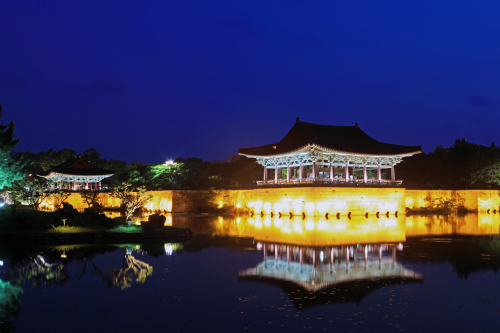Gyeongju in North Gyeongsang Province was the center of politics, economy and culture in the ancient Silla Kingdom (B.C. 57-A.D. 935) for 992 years. The Wolseong Palace, the seat of Silla, was also called Banwolseong Palace, as the palace was shaped in banwol, or a crescent.
Around the Wolseong district, the most eye-catching relic is Cheomseongdae, or Cheomseong Observatory, the oldest astronomical observatory in Asia. In keeping with the 361 days a year found in the lunar calendar, the observatory was built with 361 stones. The 28 stairs point to the number of the zodiac, 28, and the upper 12 stairs from the window and the 12 stairs below the window represent the 24 divisions of the year under the lunar calendar.
 |
Anapji in Gyeongju, North Gyeongsang Province |
On the way from Cheomseong Observatory to the Wolseong Palace, you will find Gyerim Wood, the sacred spot filled with ancient trees. It is known for the tale that Kim Al-ji, the founder of the Kim clan of Silla, was born in the woods.
If you go up to the Wolseong Palace, there will be Seokbinggo, an icehouse where ancient Koreans used to store ice.
Across from the Wolseong area sits Anapji, or Anap Pond, where upper-class Silla people used to frequent. Constructed by order of King Munmu in 674, the pond is an oval shape.
Namsan, or South Mountain, has been the center of Buddhist culture. Although a millennium has passed, there are still 121 temple sites, 87 Buddha statues and 71 stone pagodas.
The most essential tour course is Samneunggol Valley, where Buddhist relics are spread from the entrance to the top. Baeri Samjonbul, the three Buddhist statues, are known for their gentle smiles. Hiking up the mountain along with the thick pine trees gives brings the pleasure of silence and peace.
Past the pine tree forest, you will first meet Seokjo Yeorae Jwasang, or stone seated Buddha, without a head. Then, another Buddha called Maae Gwaneumbosal engraved on a stone wall will appear. A round face with red-tinted lips looks unusual. After climbing up to the top, you will find the 5-meter tall Buddha, the largest one in Samneunggol Valley.
The Bulguksa Temple and Seokguram Grotto were registered as UNESCO World Cultural Heritage in 1995. In 2000, five districts in downtown Gyeongju were designated as World Cultural Heritage under the name, “Gyeongju Historical Areas.” For more information, call (054) 779-6077.
(Source: Korea Tourism Organization)
How to get there:
- By train: Take the KTX from Seoul Station to Sin Gyeongju Station. It will take about 2 hours and 10 minutes.
- By bus: Take the bus from Gangnam Express Bus Terminal to Gyeongju. It will take about 4 hours.
- By car: Take the Gyeongbu Express Way and come out at Gyeongju IC. Head for Oreung intersection and follow the sign, Wolseong Historical Site District.
Related Websites:
- www.gyeongju.go.kr
- guide.gyeongju.go.kr
- www.cultureexpo.or.kr
- www.smpark.co.kr
By Kim Yoon-mi (
yoonmi@heraldcorp.com)








